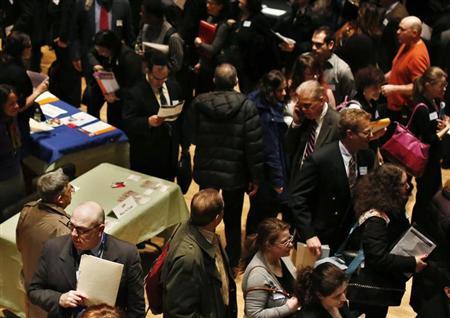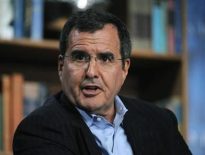(Reuters) – Americans giving up the hunt for jobs were likely behind a sharp drop in the U.S. workforce last month, a bad sign for an economy that is struggling to achieve a faster growth pace.

The number of working-age Americans counted as part of the labor force — either with a job or looking for one — tumbled by 496,000 in March, the biggest fall since December 2009, the Labor Department said on Friday. That pushed the so-called workforce participation rate to a 34-year low of 63.3 percent.
March marked the second month in a row that the participation rate declined — 626,000 people have dropped from the work force since January.
Friday’s report showed a decline in the number of discouraged job seekers last month after a pop in February, which at first glance might suggest the drop in the workforce was mainly because of shifting demographics.
But a closer look at the underlying numbers raises questions about the notion that retiring baby boomers were the driving force behind the shrinking workforce.
“You have to think that it’s a large part demographics, but demographics are not really going to have such a big effect on month-to-month changes,” said Keith Hall, senior research fellow at George Mason University’s Mercatus Center.
Of the nearly 500,000 people dropping out, just 118,000 were aged 55 and older, meaning more than three-quarters of the increase came from below-retirement-age adults.
Also, the number of people 65 and older counted as part of the workforce actually rose by 27,000, which followed a 72,000 increase in February.
Hall said the sluggish economy was forcing some older Americans to continue working to rebuild retirement nest-eggs that were shattered during the 2007-09 recession.
Indeed, the participation rate for Americans between 55 and 64 years old held steady at a relatively high 65 percent. On the other hand, participation by the 25-29 age group was the lowest since record-keeping started in 1982.
“People are just giving up the search for work. A lot of them would like to work and they aren’t, that is a serious sickness in the economy,” said Peter McHenry, assistant economics professor at the College of William & Mary in Williamsburg, Virginia.
The drop in participation helped to lower the unemployment rate by a tenth of a percentage point to 7.6 percent. If the workforce had not contracted, the jobless rate would have risen two-tenths of a percentage point to 7.9 percent in March.
LONG GRIND
Since the recession ended, the economy has struggled to grow at a more than 2 percent pace. Economists say growth of more than 2.5 percent is needed over a sustained period to generate the number of jobs sufficient to reduce unemployment.
In March, the economy added an anemic 88,000 jobs, the fewest in nine months.
Some economists said the shrinking workforce was also likely the result of people falling off state unemployment benefit rolls. Jobless aid recipients are required to be actively looking for work.
“When that incentive is no longer available, they withdraw,” said Patrick O’Keefe, head of economic research at CohnReznick in Roseland, New Jersey. “The persistently high ratio of job seekers to job openings is such that discouragement is high.”
Falling participation, especially among young Americans, is troubling and could have long-lasting effects on the economy.
“For the young who are getting out of school, studies show a lot of their earnings growth comes in the first 10 years after they get out of school,” said Hall, a former Bureau of Labor Statistics Commissioner.
“We’re seeing a great deal of underemployed in youth and great disengagement, they are not participating in the labor market yet.”
Not only will this trend hurt productivity, but the resulting low wages will reduce consumption, holding back economic growth. It could also complicate things for the Federal Reserve, which has made the labor market the focus of monetary policy.
Economists were concerned because the drop in the workforce came even though job growth had strengthened somewhat between July and February.
Michael Feroli, an economist at JPMorgan in New York, said the workforce decline cast doubts on hopes that improving labor market conditions would pull discouraged workers back into the labor force.
“The idea that labor force participation is structurally or institutionally impaired gains increasing credence with each passing jobs report,” said Feroli.
(Reporting by Lucia Mutikani; Editing by Leslie Adler)





